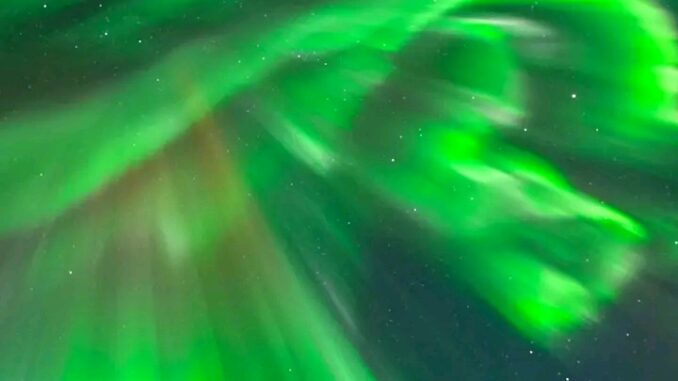
Northern Lights Forecast Update: where to see Aurora Borealis Tonight
Tonight, skywatchers across parts of the United States may be treated to a spectacular natural light show as the Northern Lights, or Aurora Borealis, are forecast to be visible in several states. This rare opportunity is due to heightened solar activity, which is expected to produce vivid auroras even at lower latitudes than usual.
The Aurora Borealis is typically seen in high-latitude regions near the Arctic, including parts of Canada, Alaska, and Scandinavia. However, during times of intense solar activity, the lights can extend further south. The solar storm that is expected to peak tonight, caused by a coronal mass ejection (CME) from the sun, has heightened the potential for auroras to be seen as far south as parts of the northern United States.
### Where to See the Northern Lights Tonight
The best chances of viewing the Northern Lights tonight will be in states with northern latitudes, such as Minnesota, Michigan, Wisconsin, and North Dakota. Areas with clear skies and minimal light pollution will offer the most spectacular views. However, even residents of southern states like Illinois, Iowa, and even parts of New York could see the Aurora Borealis under ideal conditions, provided they are far from city lights and the skies are dark enough.
In particular, locations like the Upper Peninsula of Michigan, the northern parts of Minnesota, and the plains of North Dakota are expected to have prime viewing conditions. The aurora may even be visible along the northern edge of the Great Lakes, making it an exciting opportunity for stargazers in both urban and rural settings.
### What Causes the Aurora Borealis?
The Aurora Borealis occurs when charged particles from the sun interact with Earth’s magnetic field and atmosphere. These particles are funneled toward the poles, where they collide with gases like oxygen and nitrogen in the Earth’s atmosphere, causing them to light up in a dazzling array of colors. The result is the shifting, shimmering lights that can range from green to purple, red, and even white.
The phenomenon is most commonly seen in regions close to the magnetic poles. However, solar storms—such as the one expected tonight—can send additional charged particles toward Earth, creating auroras that are visible farther south than usual.
### What to Expect Tonight
According to experts from the NOAA Space Weather Prediction Center, the geomagnetic storm associated with the solar event is expected to peak late in the evening and into the early hours of the morning. The storm is categorized as a G3 level storm on the NOAA’s five-level scale, indicating a moderate-to-strong solar event capable of producing auroras at lower latitudes.
While the intensity of the auroras may vary, viewers can expect a light show that could last for several hours. The most vivid displays are likely to occur between midnight and 3:00 a.m. local time. Those hoping to catch a glimpse should find dark areas away from artificial light and be prepared for potentially chilly temperatures, especially in northern regions.
### Tips for Viewing the Aurora Borealis
For those eager to see the Northern Lights tonight, there are several tips to enhance the viewing experience:
1. **Go North**: The farther north you are, the better your chances. Areas close to the Canadian border or at higher elevations will have the clearest views.
2. **Find Dark Skies**: Light pollution can obscure the aurora, so it’s essential to find a location away from city lights.
3. **Check the Weather**: Clear skies are crucial for a successful aurora viewing. Cloud cover will make the lights difficult, if not impossible, to see.
4. **Dress Warmly**: Temperatures in northern states can drop significantly at night, so it’s important to bundle up in layers to stay comfortable while waiting for the show.
### Why This Event Is Special
While auroras are a regular occurrence in the far northern regions, this particular solar storm marks a more unusual event for observers further south. Solar activity tends to follow an 11-year cycle, with heightened activity occurring during periods known as solar maximums. This storm is part of the ongoing solar cycle 25, which is expected to peak in 2025, making this an exciting preview of what’s to come in the next few years.
For many, witnessing the Northern Lights is a once-in-a-lifetime experience. Tonight’s forecast provides an exceptional opportunity for stargazers across the northern U.S. to see this breathtaking phenomenon firsthand. If you’re lucky enough to catch a glimpse, it’s sure to be a memorable and awe-inspiring event.

Leave a Reply